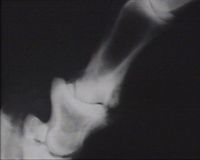Degenerative Joint Disease
Also known as: DJD — Osteoarthritis — Degenerative Arthritis — Osteroarthrosis
Introduction
Degenerative joint disease is the progressive deterioration of articular cartilage and is characterised by hyaline cartilage thinning, joint effusion and periarticular osteophyte formation.
Osteophytes form at the junction between synovium and bone. Joint inflammation leads to the release of factors which drive cells to multiply and differentiate into chondroblasts and osteoblasts. There is matrix deposition, mineralisation and growth of the osteophyte. Mineralised osteophytes develop a trabecular structure and retain a cartilage surface, and when mature may become incorporated into the metaphysis itself.
Chondrocyte necrosis is initiated, degradative enzymes are released and synovitis, continued cartilage degradation and inflammation occur. There is loss of proteoglycans and lubrication in the joint.
Normal joint function is altered by abnormal cartilage congruency and joint capsule anatomy.
Pain, lameness and muscle atrophy develop secondary to joint dysfunction.
DJD is the end-stage to many common diseases of small and large animals and therefore prompt diagnosis and management of these diseases is critical in preventing the condition.
Predisposing Factors
These include any condition causing:
- joint trauma: repetitive or acute trauma, intra-articular fractures
- joint instability/dysplasia: luxations and subluxations, hip dysplasia, elbow dysplasia, cruciate disease
- joint incongruity: conformational abnormalities, congenital malformations, osteochondrosis, Calve Legg-Perthe's Disease
Clinical Signs
These include: lameness, pain, joint swelling, muscle atrophy, pericapsular fibrosis, crepitation and decreased range of motion.
Diagnosis
A history of joint disease is common.
Radiography will reveal: joint effusion, periarticular soft tissue swelling, osteophytosis, enthesitis, subchondral bone sclerosis and narrowed joint space. It is important to note that radiographic changes do not always correlate with clinical signs and not all degenerate joints are associated with lameness.
Arthrocentesis is usually unremarkable, but may reveal slight changes in viscosity, colour and volume.
In horses, less severe cases may require arthroscopy for diagnosis.
Treatment
Treatment should rely principally on rest, controlled exercise and pain relief.
In small animals, an important treatment parameter is weight reduction or control.
Exercise modification/physiotherapy: animals should be put on an appropriate exercise regimen, using analgesia initially and to control flare-ups. Some dogs enjoy hydrotherapy.
Drug therapies: should include NSAIDs and opioids in severe pain. In small animals, example include: carprofen and meloxicam systemically. In horses, systemic phenylbutazone can be given as well as intra-articular injections of steroids, hyaluronic acid and glycosaminoglycans. Corticosteroids should only be given to severe, non-responsive cases and never combined with NSAIDs.
New therapies: acupuncture has become more popular in small animals.
Neutraceuticals such as glycosamide sulphate, chondroitin sulphate and pentosan polysulphate might improve signs, however few controlled studies in dogs and horses are available to support any claims.
Surgical treatment options include:
- Joint lavage: minimally invasive and may help remove inflammatory mediators and improve clinical signs for several months
- Salvage procedures such as:
- Excision arthroplasty: in small animals, for example Femoral Head and Neck Excision
- Replacement arthroplasty: total hip replacement and total elbow replacement in dogs
- Arthrodesis: in all species depending on the joint, carpal arthrodesis in dogs, pastern and hock joint arthrodesis in horses, fetlock as a last resort.
- Amputation in small animals in cases of intractable pain or where financial issues prevent any other treatment.
Ultimately, DJD is an incurable disease and conservative treatment will only slow the progression of the disease.
Prognosis
Prognosis depends on the location and severity of the arthropathy, but is usually guarded for return to athletic function.
| Degenerative Joint Disease Learning Resources | |
|---|---|
 Test your knowledge using flashcard type questions |
Equine Orthopaedics and Rheumatology Q&A 10 |
References
Kahn, C. (2005) Merck veterinary manual Merck and co
Corr, S. (2009) Locomotor module: osteoarthritis RVC student notes
Lewis, D. (1998) Small Animal Orthopaedics: self-assessment colour review Manson Publishing
| This article has been peer reviewed but is awaiting expert review. If you would like to help with this, please see more information about expert reviewing. |
Error in widget FBRecommend: unable to write file /var/www/wikivet.net/extensions/Widgets/compiled_templates/wrt662204c9723cb7_21084821 Error in widget google+: unable to write file /var/www/wikivet.net/extensions/Widgets/compiled_templates/wrt662204c9772983_05295150 Error in widget TwitterTweet: unable to write file /var/www/wikivet.net/extensions/Widgets/compiled_templates/wrt662204c97a62c0_83100543
|
| WikiVet® Introduction - Help WikiVet - Report a Problem |
